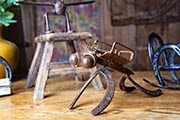When did you realize you loved art and wanted to be an artist?
I can't recall a time when I wasn't aware I loved art. Books, music, and visual arts were all valued in my family. As a child, I loved to draw and was inspired by the sketching of an older sister as well
as my great uncle's amateur painting and sculpting. When I asked for quality drawing supplies they were given, along with the imperative to treat them with respect and practice basic skills first.
However, family role models made their living in “more practical
ways. I didn't conceive of art as a career choice until much later in life. I flirted with the idea of applied art as a young adult, but didn't actually make the move to painting full time til pushing 50, after many years as a social worker. By that time, the backing and support of an exceptional spouse made the risk more feasible.

Who has been your mentor, or greatest influence to date?
I wouldn't say I've had a mentor per se, though living in Charleston, I've had the luxury of example and interaction with many fine artists. While few are traditional realists like myself, there is always something to learn from one's masterful use of
color or another's exceptional composition skills. The generosity of successful artists with technical tips and career advice often amazes me. I'm grateful to Rick Reinert and others who have nurtured my confidence along the way and “nudged” me at key moments to shoot for a high profile show or opportunity that paid off.
Who is another living artist you admire and why?
One of several who come immediately to mind is Mary Whyte, a Charleston watercolor artist of international renown. I've long admired her mastery of watercolor but did not recognize how exceptional she is until seeing a major body of her work recently in her “Working South” exhibition. Each piece is an evocative gem of dynamic composition, rich color and texture, and masterfully rendered images that express the character and personality of each worker and workplace environment. Pieces are all part of a totally coherent and integrated concept. It's as though she “wrote a book in pictures” that tells the tale of a disappearing way of life and makes you feel you know all the characters. How can you fail to admire an artist who can do that?
What is your favorite surface to create work on or to work with? Describe it if you make it yourself.
I paint on prestretched primed canvas or linen. As a slow painter, I find these far too satisfying to be tempted to invest time in making or preparing my own. I love the “spring” of canvas against my touch. A good even medium tooth weave interacts beautifully with my brushes and varying strokes to create textural illusions while
still being “flat” enough to allow precise lines and details when needed.
What are your favorite materials to use?
Simply, professional grade Winsor Newton Oils, odorless mineral
spirits for solvent, and refined linseed oil as a medium. For brushes I like hog bristle for underpainting and certain textures.
I like soft red sables for details, clouds, blending edges, etc.
Do you have a favorite color palette?
My basic palette is:
Titanium White, Naples Yellow, Ochre, Cadmium Lemon, Cadmium Yellow Deep, Raw Umber, Rose Madder Genuine,
Cobalt Violet, Cerulean Blue, French Ultramarine, and Ivory Black
(added recently and used “rarely and sparely” in mixes of darkest darks). Cadmium Red, Gamlin Radiant Red, and Gamlin Radiant Magenta are included occasionally for specific pieces. Certainly, I could manage well with fewer colors, but find all these useful so
“why not?”























